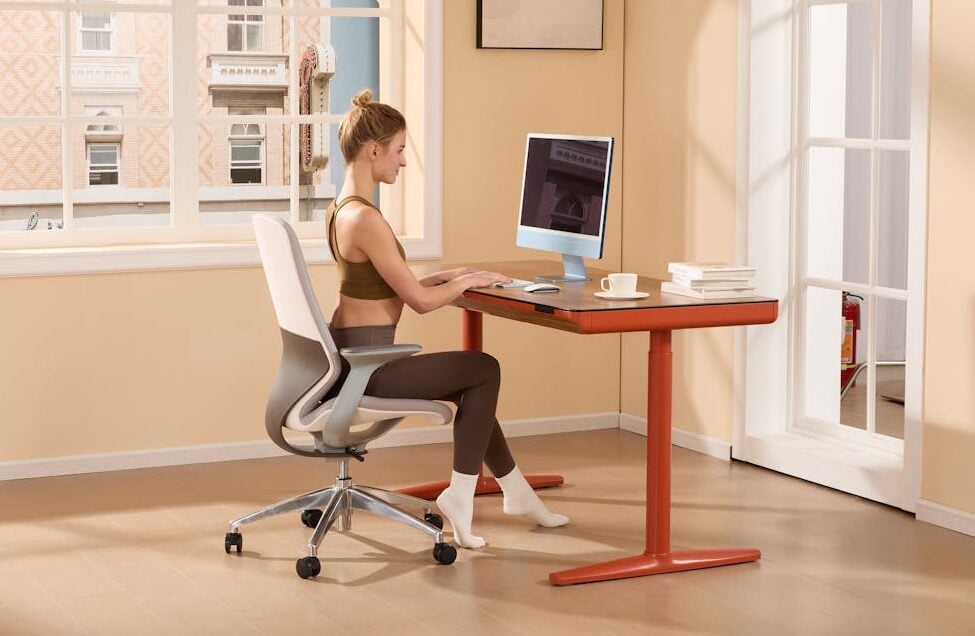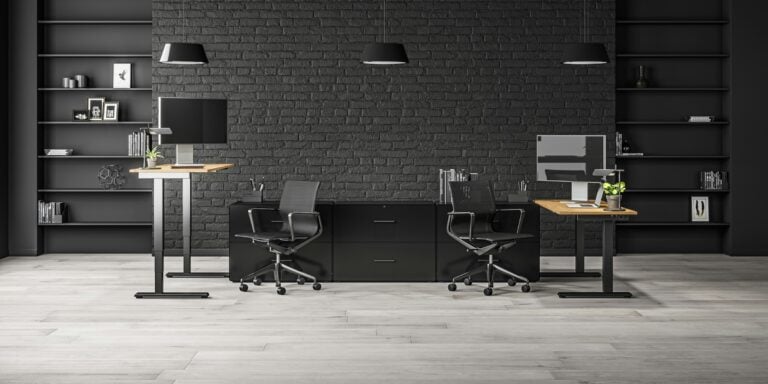Office Ergonomics for Short People and Petite Women

In the U.S., the average height for women is 5’3″, while for men it is 5’9″. Heights below these averages are often viewed as short. However, perceptions of what is considered “normal” versus “short” can differ across countries and ethnicities.
Globally, average female heights range from 4’11” to 5’7″, while average male heights typically fall between 5’3″ and 6′.
Regardless, most desks and office chairs lack the appropriate minimum height and ergonomic adjustability for shorter people. As a result, short men, average-height women, and especially petite women can have a difficult time finding ergonomic desks that comfortably accommodate their body type.
So what can be done about this?
Fortunately, there are options out there for short men and women, which we will explore in greater detail in this article.
Why adjustability is important
People of the same height can have varying arm, torso, thigh, and leg lengths. This is why it’s essential to select office furniture that allows for ergonomic adjustments in multiple areas.
The Problem with Average-Height Desks

Most desks have a minimum height of about 28″ to 30″ from the floor to the desktop surface. While this works well for taller individuals, it’s often too high for shorter users.
Why desk height matters
According to ergonomic guidelines, your feet should be flat on the floor, and your elbows should be at about a 90° angle while typing in a seated position. However, with average-height desks, shorter people are forced to compensate by raising their shoulders or sitting on the edge of the chair, both of which can lead to significant musculoskeletal strain.
Enter Standing Desks

To avoid these issues, one of the best solutions for shorter individuals is using a height-adjustable standing desk. These desks let you fine-tune the desktop height for both sitting and standing positions, which is essential for achieving proper ergonomic alignment.
So What Is the Best Minimum Desk Height for Shorter Users?
For people between 4’11” and 5’7″, look for standing desks with a minimum seated desk height between 21″ and 25″.
The Problem with Office Chairs

Seat Height
When it comes to choosing the right office chair, your overall height isn’t the only factor to consider. Your lower-leg length while seated—referred to as popliteal height—plays a key role in choosing a chair with an appropriate minimum height.
Most standard office chairs adjust to a seat height of about 16″ to 21″ from the floor, accommodating individuals with a popliteal height between 15″ and 19″—typically those 5′0″ to 6′2″ tall.
However, if your popliteal height is below 15″—often the case for women shorter than 5′0″—your feet may dangle even at the chair’s lowest setting.
In that case, you’ll need a chair with a lower minimum height of around 14″ to 16″ for proper support.
Keep in mind that two people of the same overall height can have significantly different leg lengths and popliteal heights, so measuring your own lower leg and comparing it to a chair’s adjustment range is more reliable than going by height alone.
Seat Depth
Short people and petite women often face ergonomic issues with office chair seat depths that are typically designed for taller people and are too long (usually 17-18 inches).
When the seat is too deep, short people often must lean forward and/or slouch to compensate. This causes them to lose back support, resulting in tension in the back, neck, and shoulders.
Either that or they may find themselves pushed back against the backrest with the front edge of the seat cutting into the back of their knees, which restricts circulation and causes numbness in the legs. This issue is particularly bad for short women, who may have shorter thigh lengths.
So, how do we resolve these seat depth challenges?
Look for chairs with adjustable seat depths of 14″ to 16″ if you are 4’11” to 5’3″ and adjustable seat depths up to 18″ if you are around 5’4″ to 5’6″. Make sure you can sit comfortably with a 1” to 2” gap behind your knees.
Armrests
For short people, many chairs have armrests that are non-adjustable or way too high.
If armrests remain above your elbow, this will force your shoulders to shrug up, which puts tension in your shoulders, neck, and upper back. This may force shorter users to remove the armrests from their chair, which transfers their weight to the chair seat and puts strain on their lower back.
To mitigate these issues, chairs with highly adjustable armrests are crucial for short people.
There isn’t just one kind of adjustable armrest, though. There are four types classified based on their adjustability, with “D” standing for “Direction.”
What Are 1D to 4D Armrests?
- 1D: Adjust up and down (height only).
- 2D: Adjust height + width (in/out or side to side).
- 3D: Adjust height + width + depth (forward/backward).
- 4D: Adjust height, width, depth, and pivot angle (inward/outward rotation).
Which Armrests Are Best for Short People?
For shorter individuals, especially petite women, 4D armrests are the most ergonomically beneficial because:
- Height adjustment helps prevent shoulder shrugging and strain.
- Width adjustment ensures your elbows stay close to your torso, reducing shoulder tension.
- Depth and pivot adjustments allow better alignment with your desk and arm length, reducing wrist strain.
While 4D armrests offer the most flexibility, they’re typically found on pricier chairs. If cost is an issue, 2D or 3D armrests are an OK alternative—just ensure they go low enough and narrow enough to support your frame properly.
Lumbar Support
Standard office chairs often place lumbar support too high for shorter individuals. This misplacement fails to align with the natural curve of the lower back (lumbar spine) for shorter people and smaller women. This results in pressure against the mid-back or upper lumbar region, causing pain, discomfort, and forcing poor posture.
Select chairs that feature adjustable lumbar support to correspond with the natural curvature of the lower back.
Tip: Adjust the lumbar support to sit just above the pelvis, supporting the natural inward curve of the spine without pushing too forcefully.
Headrest
Standard office chair headrests are often too high for shorter individuals, failing to adjust low enough to align with the natural curvature of the neck. This misalignment can push the head forward, leading to significant neck strain.
For many, removing the headrest entirely may be the best option; however, if you prefer a headrest, chairs designed for shorter individuals offer better ergonomic adjustability.
Chairs with headrests that can be adjusted to a lower position are crucial for short people and petite women. The headrest should fit comfortably into the natural contour of the neck, avoiding any forward pressure on the head.
What if you can’t afford to buy a new desk/chair?

To help improve wrist and neck posture while sitting, consider:
- An adjustable keyboard tray ($35+).
- An adjustable monitor arm ($30+)
- A desk riser ($150+)
- DIY with containers or stacks of books if you need your monitor raised.
For dangling feet, consider:
- An adjustable footrest ($20+)
- DIY with books/boxes
For back support, consider:
- A lumbar support cushion ($20+)
- DIY with a rolled-up towel or roll of paper towels secured with rubber bands and/or tape.
Conclusion
Creating the best ergonomic workspace means recognizing that one size does not fit all, especially for shorter people and petite women.
Fortunately, options for short people and petite women do exist. Height-adjustable desks, short and petite specific chairs with adjustable seat depth, and customizable armrests and lumbar support offer shorter users better support for their posture, productivity, and well-being.
FAQ
Desks with a minimum height of 21″ to 25″ are generally suitable for individuals between 4’11” and 5’7″. Ideally, your elbows should be at a 90° angle while typing.
Yes—desk risers, keyboard trays, lumbar support pillows, footrests, and their DIY alternatives can help compensate for poor height alignment.
Popliteal height is the measurement from the ground to the back of your knee when sitting down. It helps identify the optimal seat height for a chair so that your feet can rest flat on the ground and your thighs receive proper support.
An excessively deep seat may dig into the backs of your knees or make you lean forward, resulting in bad posture and discomfort. Petite users typically need a seat depth of 14″ to 16″.
Yes—if your chair is too tall and your feet don’t reach the ground, a footrest can provide stability and prevent circulation issues.
4D armrests allow adjustments in height, width, depth, and pivot. They’re ideal for short people because they offer more precise alignment with your body and desk setup.
Look for adjustable lumbar support that fits the natural curve of your lower back. Petite users often require lumbar support positioned lower than taller users.
Only if they’re adjustable. Many headrests sit too high and push the head forward, causing neck strain. Choose one that conforms to the natural curve of your neck—or remove it entirely if it’s not helping.
Both sitting and standing can be ergonomic if your workstation is adjusted correctly. Standing desks offer flexibility for both sitting and standing while you work.
Yes, several manufacturers now offer chairs with lower seat heights, shorter seat depths, more adjustable arm rests and better lumbar placement tailored to smaller body frames.



